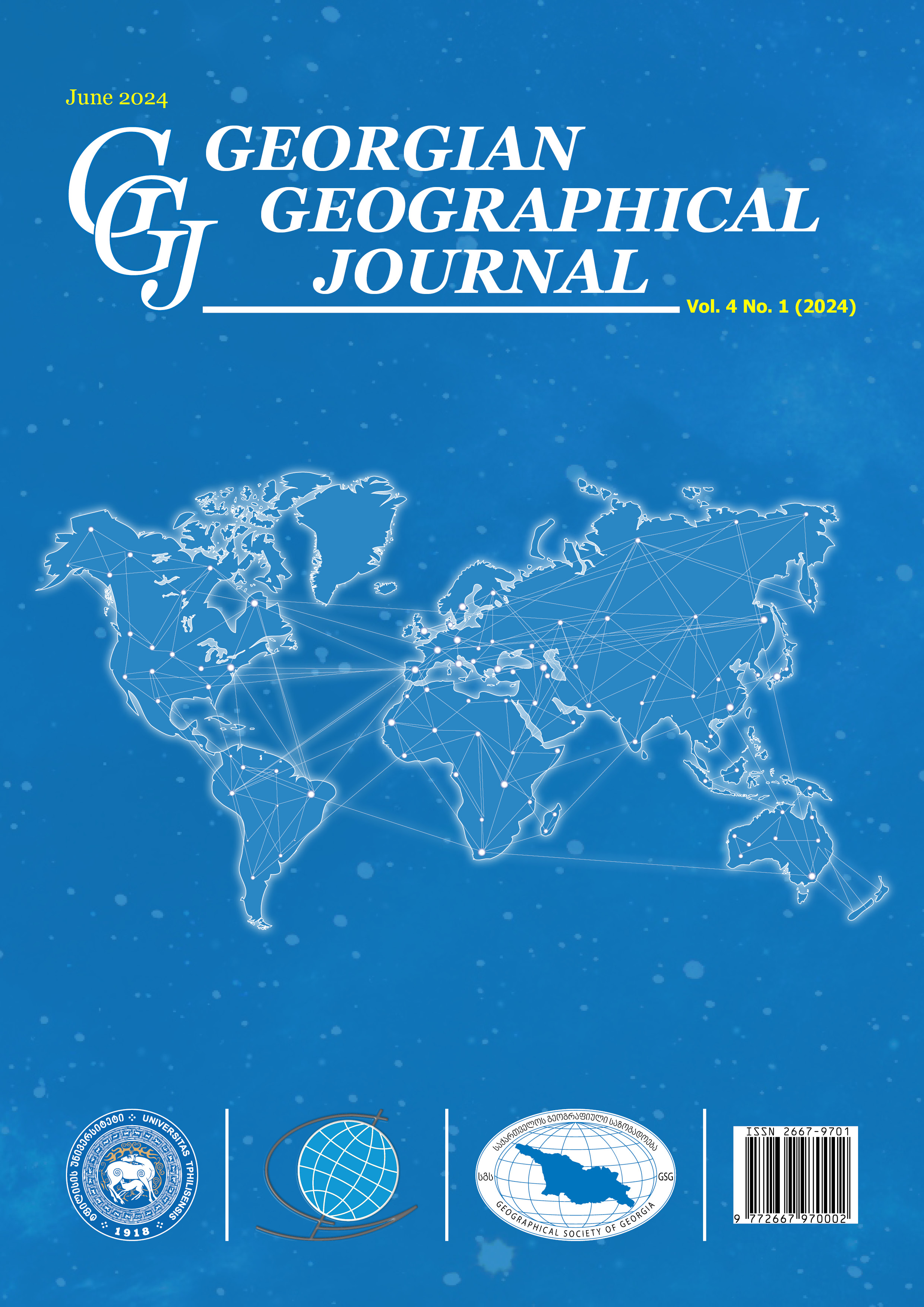Risks of Sustainable Environmental Management for the Purpose of Developing Regional Tourism (on the Example of the Lankaran Natural Region)
DOI:
https://doi.org/10.52340/ggj.2024.04.01.03Keywords:
landslide processes, anthropogenic impact, landslide hazard, ArcGIS technologies, recreationAbstract
Currently, reconstruction and redevelopment of inhabited areas is taking place in the natural area of Lankaran, and the area of construction work is also increasing in new, previously undeveloped areas, primarily due to the intensive development of the tourism and recreational industry. The high-quality functioning of the territory is unrealistic without taking into account the factors and patterns of manifestation of landslide processes, the dynamics and forecast of their development. During the study, a pattern of expansion of landslide processes was identified and the intensity of their manifestation was analysed. To study landslide processes, in addition to expeditionary geological-geomorphological, landscape work and stock materials, remote sensing data was used. When conducting landslide hazard analysis, high-resolution satellite images (CNES/Airbus, Maxar Technologies (GeoEye-1), and medium-resolution Sentinel-2A and 2B satellite images were mainly used. Visual and semiautomatic decoding (classification with training) was carried out in the ArcGIS environment. The compiled map for assessing the recreational potential of landscapes is recommended to use as monitoring and timely response to the state of the landscape-geological-geomorphological situation in the Lankaran natural area.
Downloads
References
Akgün, A., & Bulut, F. (2006). GIS-based landslide susceptibility for Arsin-Yomra (Trabzon, North Turkey) region. Environmental Geology, 51(8), 1377–1387. https://doi.org/10.1007/s00254-006-0435-6
Asadian F., Arzjani Z., Varavipour M. (2010) Changes of microenvironment in Gilan citydue to landslides./Carpathian Journal of Earth and Environmental Sciences, #5(1), p. 93–102.
Gulieva S.Yu., Kuchinskaya I.Ya., Karimova E.J. (2014). Problems of sustainable development of mountain geosystems of Azerbaijan in the conditions of intensive anthropogenic development/Geopolitics and ecogeodynamics of regions, Simferopol, #10, pp. 490–497.
Guliyeva I.F. (2018) Dynamics of development of modern landscapes of the Talysh mountains and their recreation potential assessment. Baku, dissertation abstract.
Guzzetti, F., Reichenbach, P., Cardinali, M., Galli, M., & Ardizzone, F. (2005). Probabilistic landslide hazard assessment at the basin scale. Geomorphology, 72(1–4), 272–299. https://doi.org/10.1016/j.geomorph.2005.06.002
Kuchinskaya I.Y. (2004). Landscape and ecological differentiation of mountain geosystems. Azerbaijan, Baku: Victory, 2011.
Lee, E. M., & Jones, D. K. (2014). Landslide risk assessment. https://doi.org/10.1680/lra.58019
Madatzade A.A., Shikhlinsky E.M. (1968). Climate of Azerbaijan. Baku, 341 p.
Metternicht, G., Hurni, L., & Gogu, R. (2005). Remote sensing of landslides: An analysis of the potential contribution to geo-spatial systems for hazard assessment in mountainous environments. Remote Sensing of Environment, 98(2–3), 284–303. https://doi.org/10.1016/j.rse.2005.08.004
Mammadov S.G., Tarikhazer S.А. (2023). Aplication of quantitative methods for the assessment of landslide susceptibility of the Girdimanchay river basin/News of Tula State University, Russia, Tula, #1, p. 38–67.
Mardanov I.I., Ismailov M.J., Tarikhazer S.A., Karimova E.J. (2018). The transformations of slope slide landscapes of Great Caucasus: possibilities of discovering of main factors/Selçuk Üniversitesi Mühendislik fakültesi, Bilim ve Teknoloji Dergisi. Turkey, Istanbul, #6, pp. 787–797. DOI: 10.15317/Scitech.2018.168
Solovova A.T. (2007). Assessment of the recreational potential of the Chita region and its use/Geography and natural resources, #2, p. 128–133.
Tarikhazer S.A. (2020). Modern landslide processes of relief formation in the Greater Caucasus (within Azerbaijan)/News of Tula State University. Geosciences. Russia, Tula, #1, p. 120–136.
Tarikhazer S.A. (2019). Growth of ecogeological stresses in mountainous geosystems in the conditions of activation modern geomorphodynamic processes (on the example of Azerbaijan)/The Bulletin the National Academy of sciences of the Republic of Kazakhstan. Kazakhstan, Almaty, #6, pp. 34–43 https://doi. org/10.32014/2019.2518-1467.143
Tarikhazer S.A. (2020). The geographical prerequisites for the identification and prevention of dangerous geomorphological processes in the mountain geosystems of the Alpine-Himalayan belt (on the example of the Major Caucasus of Azerbaijan)/Journal of Geology Geography and Geoecology. Ukraine, Dnipro, #29(1), pp. 176–187 DOI:10.15421/112016
Tarikhazer S.А., Mammadov S.G., Hamidova Z.A. (2023) Application of quantitative methods for the assessment of landslide susceptibility of the Aghsuchay river basin/Bulletin of the National University of Kharkov named after. V.N. Karazin, series “Geology. Geography. Ecology". Ukraine, Kharkov, #58, p. 257–273 https://doi.org/10.26565/2410-7360-2023-58-20
Downloads
Published
How to Cite
Issue
Section
License
Copyright (c) 2024 Georgian Geographical Journal

This work is licensed under a Creative Commons Attribution 4.0 International License.
This work is licensed under a CC BY Attribution




